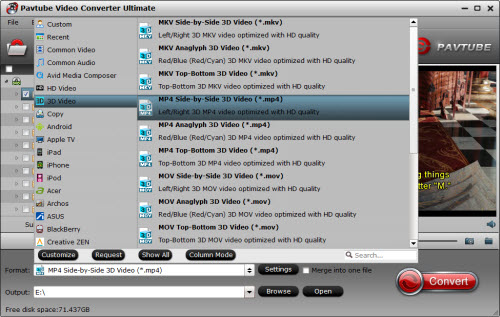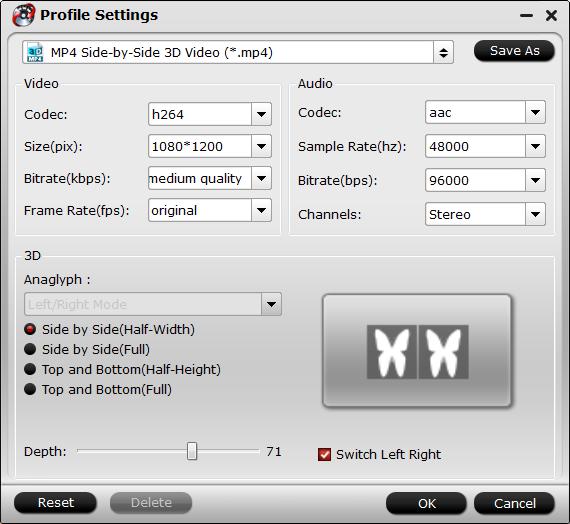ASUS's first mixed reality headset has plenty of pleasant surprises: light, powerful and fun to use, it's well worth a look. Most of the technology inside is common across all of the manufacturers, but ASUS has worked hard to make its offering unique where it can. For example, it used a polygonal-art covering for the visor, ensuring that it looks much nicer than, say, Acer's View Master-esque offering. Similarly, ASUS's headset feels much lighter than its rivals' models, and the company included an antimicrobial cushion inside.
Want to experience movies on ASUS Windows Mixed Reality Headset with perfect 3D visual effect? The following part will show you how to make this job completed.
Prepare 3D Movie Source for ASUS Windows Mixed Reality Headset Viewing
Nowadays, several sites allow you to rent movies by mail or stream them straight to your computer. Let's look at these websites that allow you to get 3D content.
1. UVerse
2. Family Video
4. Vudu
5. Comcast
7. Amazon
8. 3D Party
Read more: Free 3D Movies Download Website
Create 3D Movies for ASUS Windows Mixed Reality Headset
Do you still spend much money on 3D movies? Want more 3D video files? Here, you can save much money and energy, I recommend you the powerful 3D movie creator which can provide you the best 3D videos without much cost: Pavtube Video Converter Ultimate for Windows/ Mac.
With this powerful 3D movie maker, you can not only make 3D movies from 3D Blu-ray, but also from 2D Blu-ray/DVD and various common files formats. The program helps to create 3D movies with the format of MP4, MKV, MOV, AVI, WMV with different 3D mode: Side by Side, Top and Bottom and Anglyph for viewing on 3D video players via ASUS Windows Mixed Reality Headset. When you get the 3D videos, you can also watch the 3D videos on any 3D TV, 3D projectors at will.
Adjust output 3D profile settings
Besides that, you can also do some 3D profile settings, you can adjust the 3D video depth value to get better 3D effect, switch left right image to change the displaying order for 3D SBS movies, or switch between "Red/Blue Anaglyph" or "Red/Green Anaglyph" for 3D Anaglyph videos, etc. according to your own needs.
How to Create 3D Video for Viewing on ASUS Windows Mixed Reality Headset?
Step 1: Load Video or DVD/Blu-ray disc
Launch the program on your computer, click "File" menu and select "Add Video/Audio" or "Add from folder" to import source video to the application. For loading Blu-ray or DVD disc, insert your Blu-ray/DVD disc into an external Blu-ray/DVD drive, click "File" > "Load from disc" option.
Step 2: Select SBS 3D MP4 as output for ASUS Windows Mixed Reality Headset
Tap on "Format" bar and find "3D Video", there are a lot of options for you. "MP4 Side-by-Side 3D Video (*.mp4)" is recommended for ASUS Windows Mixed Reality Headset.
If necessary, you can click “Settings” to open “Profile Settings” window, here you can adjust output 3D video depth, select the specific 3D resolution: Side by Side (Half – Width) or Side by Side (Full) or change the image display order for 3D SBS movie. When you are not satisfied with the output 3D video effect, you can adjust the output 3D depth value to get better 3D depth perception. In addition, you can also use the “Switch Left Right” option to change the image display order for 3D SBS movie.
Step 3: Begin the 3D movie creation process
Go back to the main interface and start the video/Blu-ray/DVD to ASUS Windows Mixed Reality Headset supported 3D video conversion process by hitting right-bottom "Convert" button.
When the conversion is completed, click the "Open Output Folder" on the main interface to pop out the folder with generated 3D file formats. Then feel free to transfer and view them via ASUS Windows Mixed Reality Headset.
Comparing Windows Mixed Reality Headsets from Acer, ASUS, Dell, HP, Lenovo and Samsung
Windows Mixed Reality is Microsoft's hottest investment of 2017, extending the traditional desktop experience to a fully-realized virtual world. With its official debut kicking off this fall, a wide range of third-party hardware partners are already investing in the platform, with headsets from Acer, ASUS, Dell, HP, Lenovo, and Samsung. Let's take a closer look at what expect from each of these devices.
| Vision | |
| Display |
|
| Field of View |
|
| Motion | |
| Tracking | In its current implementation, all Windows Mixed Reality headsets allow for six degrees of freedom, which allows the user to move in all directions and orientations within a three-dimensional space. These headsets also adopt "inside-out tracking," which allows positioning to be calculated internally, without the need for additional external sensors. |
| Sensors |
|
| Connectivity | |
| Audio |
|
| Ports | A hard-wired connection to a Windows 10 PC is a requirement for all Windows Mixed Reality headsets launching this fall. Right now, all headsets adopt an HDMI 2.0 port for transmitting a low-latency video signal, whereas a USB 3.0 connection is used for other data, including tracking information. Both of these cables are four meters long out of the box, which allows for a fair amount of movement in almost any Mixed Reality setup. |
| Size | |
| Dimensions |
|
| Weight |
|
| Availability | |
| Release date |
|
| Pricing |
|
Useful Tips
- Watch 3D Movies on ASUS Windows Mixed Reality Headset
- Top 10 VidCoder Alternatives
- 10 Places to Get 4K Ultra Movies and TV Show for 4K TV
- Get A Way to Play ISO Files on Samsung TV From USB or NAS
- Upload ISO Files to Google Drive for Accessing on Smartphone or Tablet
- 3 Tools to Copy DVD/Blu-ray to Qnap TS-253B

 Home
Home


 Free Trial Video Converter Ultimate
Free Trial Video Converter Ultimate





